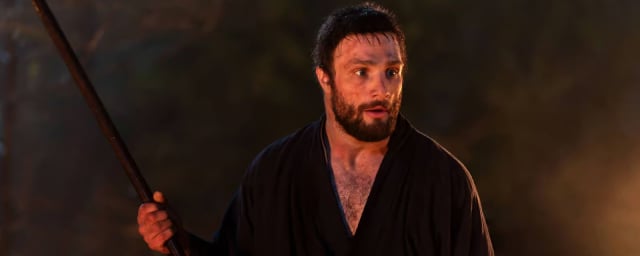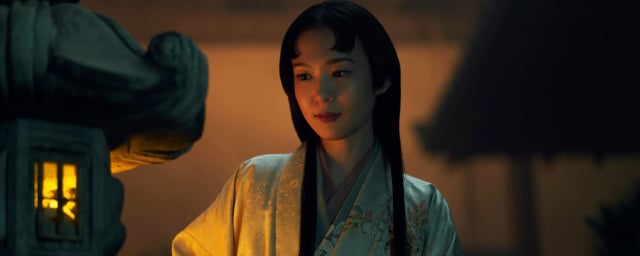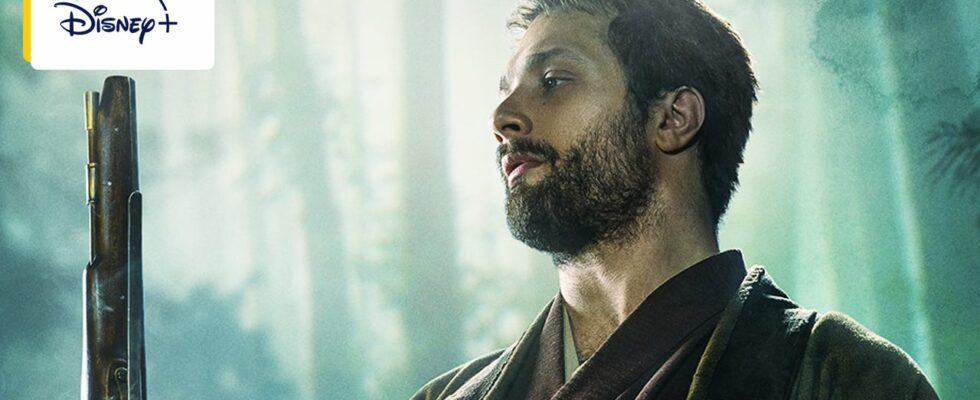A film set far from Japan, a novel inspired by the true experience of its author, a work already adapted forty years ago, the journey of the real white samurai… Here is everything you need to know to be knowledgeable about the Disney+ series .
Do you know the story of the very first white samurai? His story is told in the Shôgun series, taken from a novel inspired by authentic historical facts, and this character is still celebrated today by the Japanese. And no: this is not the hero played by Tom Cruise in The Last Samurai! Do you want to know everything about this extraordinary story? Come on, we’ll tell you all about it!
Here are five things to know about Shôgun, some of which are very surprising!
The series was not filmed in Japan!
One of Shôgun’s main qualities is his meticulous work of historical reconstruction. From kimonos to samurai armor to majestic castles, rarely has Japan of the time been presented so realistically in a series, especially American.
The large budget made available to the program is surely not unrelated to this result, since it is the most expensive series ever produced by the FX channel. How precisely, the information is kept secret, but the budget is there.
If Japan is perfectly highlighted in the series, Shôgun was not filmed in Japan at all! The shots actually took place in Canada in the Vancouver region! Certainly, it is common for American productions to relocate to their northern neighbor, but the choice not to shoot Shôgun in the country where the action takes place may still be surprising.
FX
Several reasons explain this choice. First of all, an advantageous system of tax reductions which favor filming in Canada. Then, it would have been much more expensive to undertake a relocation of production to Japan, especially since the filming took place during the Covid period with a health protocol that was still very strict, and therefore not conducive to long travel.
Finally, Canada has film studios large enough to accommodate the reconstruction of the sets. For this reason in particular, Shôgun was able to shoot largely in the studio, and the most majestic sets of the series – starting with the castle of Lord Toranaga – could be entirely built in Vancouver.
The original novel is inspired by its author’s own experience!
At the origin of Shôgun, there is a book published in 1975. This book of more than 1000 pages was a real bestseller upon its publication, a success which allowed its author James Clavell to obtain international fame. The latter’s life is very reminiscent of the intrigue of his writings, to the point that Shôgun can be considered a semi-autobiographical work.
Before making a living from his pen, James Clavell joined the army. Mobilized during the Second World War, he was taken prisoner by the Japanese army and held captive in the Changi Camp in Singapore. The particularly difficult conditions of confinement in this prison did not, however, break the spirit of the British soldier, quite the contrary.
During this period, James Clavell decides to forget his daily life by embarking on what he calls “his university years” in contact with his cellmates. Graduates or not, each of them passed on knowledge to him, which enabled the future writer to acquire the delicate art of survival.

FX
At the same time, James Clavell became passionate about Asian culture, particularly Japanese culture, from his cell. A passion that would never leave him, and which would greatly influence his literary work throughout his career. The story of John Blackthorne, this Englishman held prisoner by the Japanese, is therefore also his!
Note that Shôgun belongs to a cycle called the Asian Saga. This anthology composed of six independent parts marks the cornerstone in the work of James Clavell. This cycle consists in particular of the novel Un Caïd, inspired by his own experience as a prisoner, or the fascinating fresco Taï-Pan dedicated to the capture of Hong Kong by the British Empire, and the opium war which resulted from it. .
A popular novelist, James Clavell has also enjoyed success as a screenwriter for the cinema. If he himself wrote the screenplay for the adaptation of his novel Un Caïd, he also became known for having signed the script for La Mouche Noire (which inspired David Cronenberg to create his film La Mouche), but also for co-writing The Great Escape, one of the most famous war films ever made. There also nourished by his experience as a prisoner?
The white samurai really existed
So let’s be clear: don’t look in the history books, you won’t find any mention of a John Blackthorne in 1600s Japan. The protagonist of Shôgun was in fact created from scratch by James Clavell. But the British writer was nevertheless inspired by an authentic historical character for the writing of his hero! A certain William Adams.
Aboard the Dutch ship De Liefde (and not the Erasmus as in the series), William Adams ran aground off the coast of Japan in the year 1600. He only escaped the death penalty for piracy following an audience granted by Ieyasu Tokugawa, an ambitious lord at war with the other regent clans of the time.
Interested in his worldview, but also in his knowledge of shipbuilding, Tokugawa decides to spare Adams and grant him an official title. William Adams then became Miura Anjin, the first white samurai. The exceptional story of this sailor who entered history still gives rise today on June 15 of each year to a day of commemoration in Japan.

FX
The series shows Blackthorne acting as a sort of shadow advisor, as he absorbs a culture of which he knows absolutely nothing. A free man in appearance, he is in reality a prisoner in an open cell, since he does not have the freedom to move around that he would like. William Adams was also obliged to Lord Tokugawa: until the end of his life, he was, for example, forbidden to leave Japan to return to his native England.
Shôgun depicts a close relationship between Blackthorne and Yoishii Toranaga, the name given to the authentic lord Ieyasu Tokugawa in James Clavell’s novel. This is a fictionalized version of the facts, because the sailor did not occupy a place of great importance with the daimyo, but he actually played the role of a strategic asset in Tokugawa’s ambitions.
The latter’s destiny and his thirst for power earned him the status of the third unifier of Japan. His conquest of the shogunate introduced a lineage that spanned more than two centuries, until the Meiji Restoration in 1868 and the rehabilitation of Emperor Mutsuhito as an authority figure with full powers.
Considered the very first white samurai in history, William Adams then opened the way for other foreigners who would in turn write the history of Japan. We think in particular of Yasuke, the very first African samurai, or even Jules Brunet, the French officer who inspired the character played by Tom Cruise in the film The Last Samurai!
This story was already adapted into a series 40 years ago
The Shôgun series available on Disney+ is not the first adaptation of James Clavell’s novel. Already in 1980, a first mini-series produced by the American channel NBC met with great success in the United States, but also throughout the world, particularly in France.
This first version consisted of ten one-hour episodes starring Richard Chamberlain and the legend of Japanese cinema Toshirô Mifune. The success of the program was such that it made Japanese culture known to the general Western public; It is also estimated that the series foreshadowed the massive arrival of sushi restaurants on the American continent!
Ironically Shôgun was not a success with the Japanese. The changes made to the historical facts, and the caricatural and Western vision of the whole, have received numerous criticisms, to the point that Toshirô Mifune was criticized for having participated in the project.

FX
Despite everything remaining cult over the years, Shôgun is today getting a facelift via a new adaptation. Supported by a substantial budget, this second adaptation aims to be closer to the original novel, but also to historical facts. The choice to shoot a large part of the dialogues in Japanese also marks a break with the first version.
Many consultants participated in the design of the project, including Frederik Cryns, a Belgian historian specializing in the Sengoku period, and whose passion for Japan came to him… after the discovery of the first Shôgun series. These two adaptations are therefore as complementary as they are closely linked!
Why won’t the series have season 2?
Broadcast since February 27 on Disney+, Shôgun is undoubtedly THE essential series for the start of 2024. A real critical success, but also a public success with an average viewer rating of 4.4 out of 5 on AlloCiné, the series is also an audience hit since it has already broken the historic record for the FX channel with more than nine million American viewers each week!
However, Shôgun will not have a season 2, as confirmed by the two creators of the series Rachel Kondo and Justin Marks. The 10 episodes adapt the entire novel by James Clavell, and there was never any question of a sequel in their minds.
Add to this that a production of this magnitude requires a lot of time, so it seems unlikely – if not completely impossible – that a season 2 could see the light of day.

FX
But many Internet users do not despair, and are now demanding a second season in the form of an anthology series. Japanese history is indeed full of events and characters that could be the subject of exciting stories to tell.
Added to this are also the five other parts of the Asian Saga by James Clavell. There are therefore many avenues to explore to give a more or less direct sequel to this story.
While waiting for a decision to be officially made by FX, remember that the episodes of Shôgun can be found exclusively on the Disney+ platform!
Discover the list of series currently available on the platform!
